Do Dogs Need Boots for Snow?
I’ve received a lot of questions about dog boots for winter over the years like:
- Do dogs need to wear boots in the snow?
- Is snow bad for dogs paws?
- Do your Dachshunds wear boots in the snow?
- At what temperature do dogs need boots?
- What boots do you recommend?
Well, today I’m going to answer all of these questions by sharing what I’ve learned from hiking with my dogs in winter for over 15 years.
But first, let me tell you a little about snow and winter weather where we live.
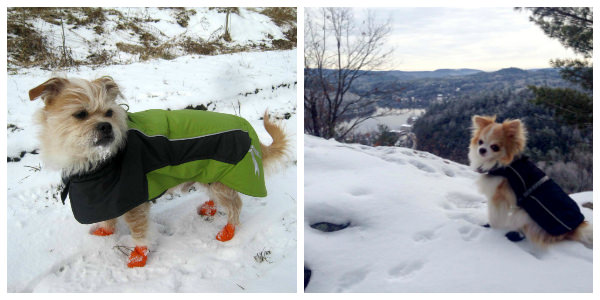
Winter Snow Conditions In the Pacific Northwest
Our snow is different than in some other parts of the country.
I remember being shocked at how light and fluffy the snow was when I visited Colorado.
Here, our snow is called “Cascade Concrete”. The snow in Washington is wet and heavy compared to a lot of other places in the country.
That means the snow often compacts down to a hard surface after it’s been walked or driven on so its unlikely to get stuck in my dog’s paws.
The compacted snow seems to bother my dog’s feet less than hiking or walking through fluffy snow.
I think, somehow, the compacted snow doesn’t feel as cold. Perhaps because it contacts less of the foot surface.
The number of winter days in the mountain that are below 20 degrees Fahrenheit are are few.
Temperatures below 10 degrees are uncommon (all of this is, of course, not accounting for any wind chill factor).
Salt on the roads and sidewalks, applied to melt snow and ice, is the biggest risk for us.
We try to avoid walking on salted surfaces when we can or not to do it for long.
I inspect my dog’s paws and wipe them off when we get home and we’ve never had a problem.
I can tell you about how my Dachshunds do without wearing boots in winter where we live but, although it’s likely transferable to your situation, I can’t make any promises.
Your experience might be different than ours.
Do Dogs Need Snow Boots to Protect Their Feet?
You’re probably wondering if snow is bad for a dog’s paws. Or asking yourself if dogs need boots.
A dog’s foot doesn’t work like a human foot.
As humans, we often attribute human characteristics to our pets. We think that if our feet get cold in the winter then so do our dog’s.
That’s not necessarily true though. If fact, it’s unlikely your dog’s feet get cold.
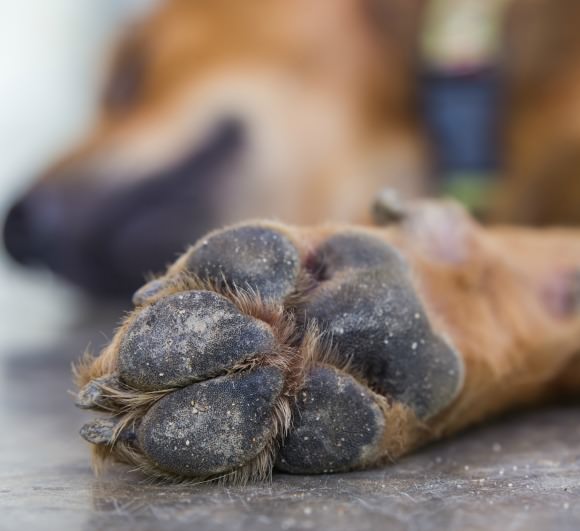
Two articles – How dogs can walk on ice without freezing their paws and Dogs Have Built-In Snow Boots, Researchers Find – explain the differences in scientific terms.
In summary:
“Dogs’ paws… have an intricate heat transfer system built in that immediately warms cold blood.
Couple that system with a high amount of freeze-resistant connective tissue and fat located in the pads of the paw, and a dog’s paw rivals that of a penguin’s wing for the ability to stay warm in crazy-cold climates.” (an arctic fox is also referenced in one of the articles)
Now, domesticated dogs are not penguins or arctic foxes of course. Most domestic pets not used to living in harsh conditions year-round.
However, the point is still the same – a dog’s paws stay warmer longer than a human foot would.
With some simple precautions, dog boots may not be necessary.
At What Temperature Do Dogs Need Boots?
Head Vet at tails.com, Sean McCormack, says:
“A dog’s paw pads are tough enough to withstand the snow, ice and frozen ground. They have adapted to the cold and are designed to survive the outside.
Body temperature plays a big part in this, as the pads draw warm blood to the skin to keep them warm. [a dog’s body temperature is approximately 5 degrees higher than a human’s]
The tissue on a dog’s paw pad is built to protect them from temperatures as low as -35 degrees.”
However, in my experience, small dogs get cold feet easier than big dogs.
My assumption is because of their small body mass, they are unable to generate as much body heat.
Personally, my 10-pound dogs have stood on snow and ice when temperatures were as cold as 8 degrees Fahrenheit but it was only for a short potty break.
We’ve been out for longer when it was about 10 degrees and some of those times my dogs have lifted their feet, signaling their feet are uncomfortable.
In my expeirence, my dog’s feet get irritated more easily when walking on surfaces that have de-icer granules on them.
I’m unclear to me whether it’s the de-icer itself irritating their feet, or if the de-icer somehow makes the snow and ice feel colder (since ice lowers the freezing point of water), but it seems they can’t tolerate temperatures as low in those conditions.
So, the bottom line is that a dog’s feet may be fine without boots in temperatures as low as 10-15 degrees F, and potentially colder.
However, you should watch for signs it’s too cold for your dog at temperaturesnearing 0 degrees.
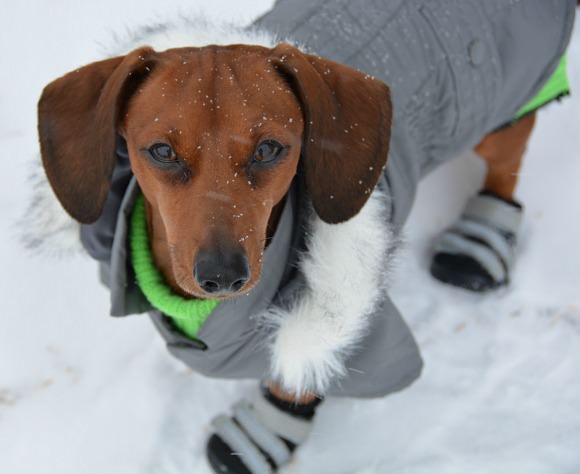
5 Things to Know About Dog Boots
1) No “traction device” is better than your dog’s naked paws
A dog’s paws are perfectly designed for them to walk on – to give them the grip and traction they need.
No dog boot will provide your dog with more traction than their natural paw would.
A boot with a thicker, more obvious tread will give more traction than one with a smooths surface but you will sacrifice flexibility of the material and it may cause them to walk unnaturally.
While boots can help protect your dog’s feet from the elements, it can also cause them to lose their footing and slip.
It’s not super common that a slip or trip injury results from a dog wearing boots but it certainly can and does.
I’ve heard of a dog with boots slipping off a cliff or slipping and cutting a tendon on the boot edge.
2) Your dog can’t perspire naturally with boots on
Your dog “perspires” through their feet, even when it’s cold out.
Even the best dog boots prohibit this natural ability to some degree.
The less breathable a dog boot is, the greater chance there is of them overheating.
It’s not likely in the snow but it’s something to be aware of.
3) It’s easier to find dog boots if your dog’s leg and paw are of a similar width
If your dog has thicker legs, so there is not such a size difference between the proportion of their foot and leg, you will have an easier time finding dog boots that fit.
By nature, Dachshunds, and some other dog breeds, have fat paws and skinny little legs.
The circumference of the cuff of the dog boot is proportional to the width…. for a “normal” dog.
The manufacturer expects that a dog with a certain width paw will have a certain leg circumference.
If your dog doesn’t fit that norm, you will have a harder time finding boots that fit.
4) The same goes for boot cuff length
Most dog boot manufacturers take into account the leg length of a dog for each respective size.
In other words, the smallest size dog boot is made to fit dogs with shorter legs. Larger dog boots are sized to fit dogs with long legs.
Dachshunds have short legs compared to the size of their feet.
Beware that a dog boot properly sized for their foot may extend over their “knee”, or up into their arm pit, and rub or chafe.
5) Dog boots can be expensive and you might keep losing them
I hear it’s very common for a dog to lose or damage a boot. We’ve certainly found several on the trail that have fallen off.
Be prepared to replace at least one, at least once, at some point.
How to Protect a Dog’s Paws Without Boots
You may have decided that your dog doesn’t need to wear boots in the snow but you still want to protect their feet.
You’re probably looking for alternatives to dog boots.
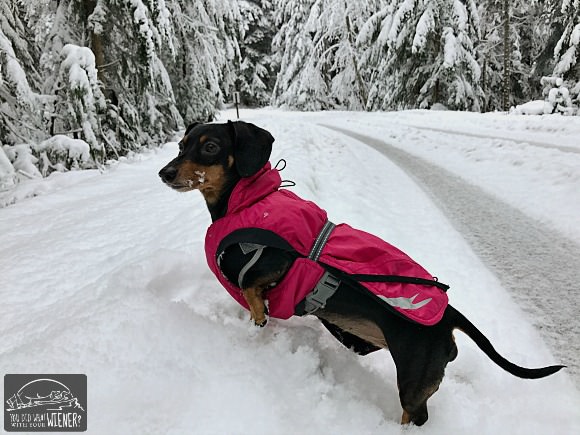
This is my recommended system if you want to skip the dog boots:
- Make sure your dog gets regular walks on a hard surface to toughen their paws.
- Trim the fur between your dog’s foot pads if it’s long or there is a lot of it so it’s harder for ice, snow and de-icing products to cling and dry on their skin, causing irritation.
- Make sure your dog has enough fur, or a dog jacket, that will keep their body extra warm when it’s cold out so heat is pushed out through their feet.
- Apply all-natural Musher’s Secret dog paw wax before you head out. This dense, breathable, barrier wax works like “invisible boots” to protect your dog’s paws from salt and chemicals, ice build-up, snowballing, and abrasions from rough ice or snow.
- Check your dog often when out on adventures. Feel their body (through fur or under their jacket) to make sure they are warm. Feel their feet to make sure they are not freezing and there is no ice or snow build-up.
Using this method, I’ve haven’t a problem in the 15 years I’ve been hiking in the northwest winters with dogs that don’t wear boots.
When Dog Boots Might Be Necessary
Sometimes the above method is not enough and your dog does need boots.
Here are some scenarios where I could see it necessary for your dog to wear boots:
- You live in an area where salted or chemically de-iced sidewalks are a thing all winter. You are afraid of salt burns on their feet or your dog has already experienced salt burns.
- Temperatures below 10 degrees F are common when you go out in the snow or ice and you’ve seen your dog lifting their feet when walking or standing around.
- Your dog’s foot pads are weak and often get cut or scraped (note: when walking in winter, dogs are more susceptible to cuts and cracks on their feet)
- Your dog is extra fluffy and snowballs stick to their fur, including around their feet and between their foot pads.
How to Choose the Right Size Boots For Your Dog
If you’ve determined your dog needs boots, how do you find the right pair?
The “right” boot is one that fit’s your dog’s foot perfectly:
- Not too snug around the foot and allows their toes to splay out naturally when they walk.
- Fit’s securely so they don’t rub or fall off.
Choosing the right size boot for your dog is as simple as measuring your dog’s feet (be sure to measure both front and back!) and comparing those measurements to the manufacturer size chart.
For more help, including instruction on how to properly measure your dog’s feet, read my guest article on the Sierra Trading Post blog about selecting a properly sized dog boot.
The correct size doesn’t ensure a correct fit though.
You will need to try the boots on your dog once you receive them to make sure they fit securely but aren’t too tight.
If they don’t seem to fit well, you may need to return them and try another brand or boot model.
Dog Boots For Winter
I have small dogs and I’ll tell ya, finding snow boots that come small enough, stay on, and don’t have a cuff that is too tall, is challenging.
My friends that own big dogs have said it can be challenging for them too.
While my Dachshund’s don’t currently wear boots, I’ve kept a close eye on what boots are available and likely to fit small dogs over the years.
Although I can only speak specifically about small dog boots for winter, most of these listed also come in sizes for larger dogs. Some up to 100 lbs!
Boots for Little Dogs
I want to be prepared in case there is ever a situation where I need boots for my miniature Dachshunds.
Note: This article contains affiliate links, which means I get a few pennies, at no extra cost to you, if you make a purchase to help support this blog (and we really, really appreciate it!)
Here are the dog boots that have caught my eye and a little about why:
Saltsox Dog Boots
These are probably the most promising dog boots for Dachshunds that I’ve found.
We’re currently trying them out.
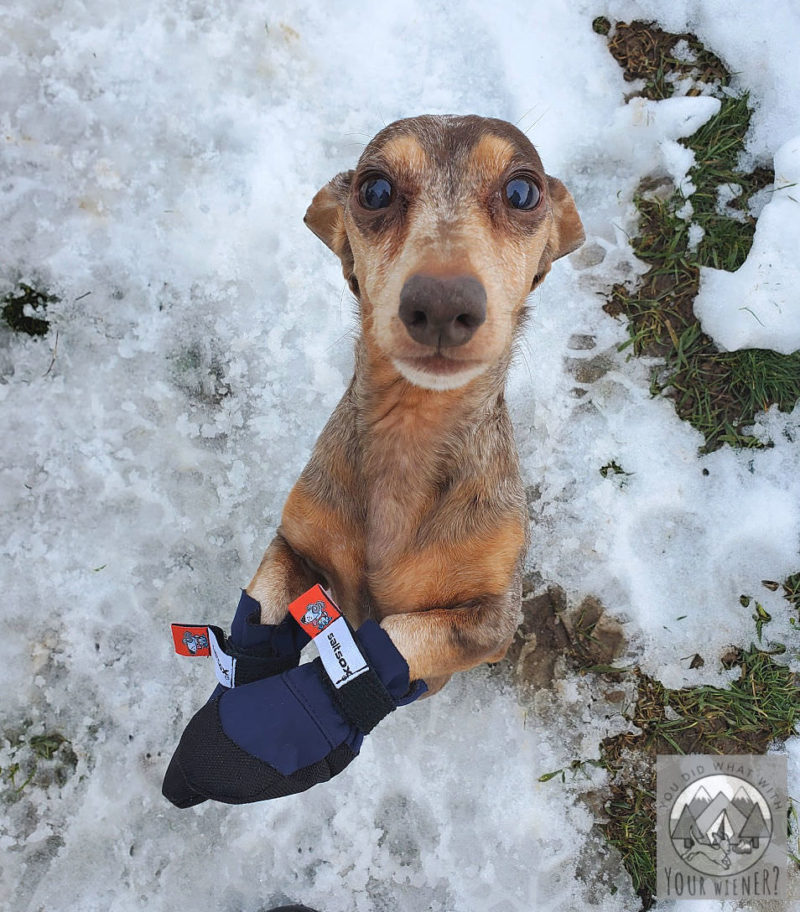
I have a friend with a 30 lb Dachshund mix that uses them regularly and loves them.
They are intended for urban use to protect from salt, snow and slush.
I don’t know how well they would work for hiking but it’s the salt protection we would likely need them for anyway.
They are made of a Neoprene-like material, are lightweight and warm .
According to their website, “the thin-sole construction promotes balance and security on icy pathways and our exclusive stretch Velcro closure ensures these boots stay on and comfortable where others have come up short.”
Muttlucks Woof Walkers All-Season Dog Boots
These were the first boots I found that had potential to be a good fit for my Dachshund.
However, the cuff length of the boot extended too far up on the leg for my liking.
They might be an option for your dog though if they have longer legs.
They have genuine leather soles that are soft flexible.
They also have self-tightening straps to provide a secure fit.
Pawz Dog Boots
These boots are like deflated rubber balloons for your dog’s feet.
I’ve heard they can sometimes tear when hiking from abrasion, sticks, or toenails that are too long.
I also know people who use them on their dog’s regularly and don’t have issues though.
They might work for hiking but they are best used for protecting your dog’s feet from de-icers on the sidewalk.
They seem like they’re less likely to feel weird on your dog’s feet since they are made of thin, flexible rubber.


About the Author
Hi, I’m Jessica. I’ve been studying the Dachshund breed since 2007, owned 3 of my own, and shared in the lives of thousands of others through their owner’s stories. When I’m not sharing what I know on this blog, you can find me hiking, camping, and traveling with my adventurous wiener dogs.

We are huge fans of the PAWZ as you know. We can go an entire winter with one pair. Also since dogs like and some say need – to feel grounded the fact that Montecristo can still feel everything “earth” is a bonus. Also… they work well to protect from hot sidewalks in summer or if cities with lots of pollution … when an hour walk turns paws dark black with “oil” and stuff … we use them as well.
I definitely like the concept of the PAWZ boots because they offer the best tactile feel. As you know I’m sure, part of how dogs “read” the world is through their feet. The least amount we can hamper that, the better. Another thing about PAWZ is that they are pretty much the only boots to fit super tiny feet 🙂 I’m going to edit the post to make sure I include that note… so thanks!
Oh yes please … so far for the “tiny” crowd (so that is smaller than xs) this is the only ones I have found. So yes!
I used your dog jacket article to pick out new ones for my girls and our trip to Mammoth Resort. The jackets I got fit well and am very happy. Lana (she doesn’t mind the snow and cold) started shaking after a few minutes, didn’t think I would need boots. After reading this article I will reconsider the Musher’s Secret since I didn’t realize that it could help with the general cold. Same with the Pawz disposal boots.
Also, it’s nice to have an other daschound owner that understands the nuances of their little bodies.
Glad you liked the jackets. Chester and Gretel shake too when we stop. The Musher’s Secret mostly helps with ice and snow not sticking so they don’t have a “big ice cube stuck to their foot”. Their website does say “helps to insulate from cold” but I’m not actually sure how it accomplishes this. Anyway, a little shaking is not a big deal as long as they are still willing to walk and stop shaking once they are moving (and you’ve felt under the jacket to make sure their body is still warm). If they start lifting their feet up though, or refuse to walk in the cold snow, boots might definitely help. Good luck and have fun in Mammoth. I have a massage-therapist friend that lives there.
I’m afraid I don’t have anything to add. I learned some facts about dogs and their feet today. Dunno why I thought their feet would get cold easily. I wonder if the same apply to cat feet. I’ve seen feral cats standing on the snow like it doesn’t bother them. Our snow is wet, heavy and turns black a day or two after it falls. Everyone uses salt too. I think you’re lucky your two don’t need boots.
I would imagine so? But I mean they’re not the same species? I just think about cougars that live outside all winter and travel on the snow.
I found this article extremely entertaining and informative (and I don’t even have a dog, haha!). I love the idea of giving dogs (and pets in general) clothing and boots that fit, especially when it comes to being protective gear, such a boots for the winter. I’ve found there are a lot of people unwilling to get their pets a jacket or boots to help them stay more comfortable in colder climates due to the stigma behind pet clothing.
The Musher’s Secret was a great alternative that I will also be passing along to many of my dog-owning friends. Thanks for the great post!
Yeah. I understand being against “dressing your dog up” but some people take their hatred for such things too far. They’re unwilling to give them the protection they might need because they think it looks silly. People in Seattle are pretty nuts about their dogs though so I don’t see that attitude much around here 🙂
Muttlucks – I love that name. Great post. I’ve never considered boots for any of my dogs. They were larger and seemingly hardier, I guess. I did have a German Shepherd Dog that ran 3 miles with me every day, but her feet never got cold.
I really enjoyed reading about the dog’s paws and how they’re naturally geared for protection. How interesting. I also never thought about snow being different in other regions. I learned a lot from this post.
Bravo!
I never gave much thought to snow being different in other regions until I started pet blogging. I’ve learned so much about other areas of the country, and the world, through their stories and tips. I definitely learned that we are lucky here – hardly any critters that can kill you, not too hot in the summer to walk, and not too cold in the winter. Sure, we have to put up with the rain but it’s an ok tradeoff 🙂
I must say I often wondered this. We don’t live where it snows, so I wondered about the necessity of boots as I see some folks use them and some don’t. Thanks for clearing that up! 🙂
Great article – we love that you are so willing to share your knowledge! Dog boots are tricky – primarily because dogs are funky about them, or can be. You’ve hit a lot of the brands we’ve tried or used. Since we’re outside in often 0 degree weather, we like to use an oil/Mushers on their feet for short potty outings and a boot for lengthy walks. Mookie is up to an hour walk with us – we found the best way to acclimate is to quickly get your dog outside (versus tromping around in your house while in their boots). Love this piece – will share with our readers!
We use the Musher’s Secret too. When I did try boots on Chester, you’re right, getting them outside where there are awesome smells and stuff is key to getting them to ignore the boots. It was that way with jackets for Chester at first two. He would stand still like a statue once I put them on. He was all raring to go though once we stepped outside.
Great information for any dog that spends time in the snow and cold! Thanks for sharing! Typically when it’s super cold and snowy, we are quickly in and out for potty breaks; we don’t spend a lot of time outside in the yucky stuff. But when we do, my dogs do have boots but honestly, neither of them are very cooperative about wearing them. Still, I’m a big believer in their effectiveness!
Yeah, most dogs are not a fans of boots until they wear them often… as far as I understand. In my “how to fit boots” article I linked to, I also talk a little about how to get your dog used to the boots.
This is a great very informative post. My dog is definitely not small at 100lbs, but he could still benefit from using some booties! We recently moved back to Minnesota and this is my dog’s first winter where the weather isn’t too enjoyable (the high here today is 4-degrees). We usually do quicker trips outside when it’s super cold out and avoid doing too much outdoors. Getting a pair of booties would be good for our dog park trips – I have a feeling he would tear them off immediately though! Thanks for sharing!
Yeah, we try and avoid outside too when it’s too cold. It doesn’t happen very often around here though. If it was bitter cold more often, we would definitely need a different solution though. Good luck if you try the boots. I think every dog hates them at first but can grow to like them if lots of treats are involved 🙂
I tried many, many times to put boots on Henrietta when she was a puppy. She acted like I was torturing her so I stopped. I do use the puppy paw balm if we go for a long-ish walk. Our temps in the winter here in Upstate NY usually come with below freezing wind chills and it’s way too cold for me to even want to walk. These are great tips and I love knowing about the dog pysiology as well. We do use pet friendly rock salt on our stairs and I will usually carry Hen up and down them, any way.
I don’t think I’ve ever known a dog to like boots right away 🙂 But, like you, I don’t see any need to fight the point. If a need ever arose, I might try to work something out then.
Out of these, we’ve only tried Pawz. Much like you though boots are not really a necessity for our climate and city. Boots are the one thing he doesn’t like wearing. I would put some training into it but he hasn’t really needed them so it’s way down the list.
I feel the same way
We’re pretty winterized, but with fresh wet snow, we toss on our PAWZ boots to prevent snowballs. I guess we could use Musher’s secret, but it’s easy to just toss on the boots. We also wear them when it is -10 or colder as the freezing temps hurt our paws even though they are pretty conditioned.
My dogs won’t wear boots. It is way too much trouble just trying to get them on. In past years we have had some trouble with salt on the roads and sidewalks and the dogs start holding up their legs and refusing to walk. I try to walk them in the snow as opposed to the salted roads and sidewalks to avoid this, but it can still happen. Our development says that they use pet-safe salt, but I’m not so sure. I went ahead and bought some of the Musher’s Secret through your link. We will give that a try. It seems like a good product and hopefully will make the pups more comfortable on our coming walks.
I do feel like Musher’s Secret is a happy medium. I hope it works for you guys.
I love this post. You are right; it makes a difference where you live. We have boots for each of our three dogs. And coats! It was -18C which translates to -0.4F this morning in Ontario. Not only is it fffffffffffffreezing, the salt and sand used to improve driving conditions is not friendly on paws. The boots aren’t fleece lined so not a huge insulator against the cold, but it must make a bit of a difference. We hadn’t purchased a pair yet for Jack when the first snowfall arrived. We would walk several feet, and he would stop and lift a paw. I dug the snow etc. out, and we continued for several more feet before he raised another paw. I’m glad we have boots.
Brrr! Yes, that is way colder than we are used to. My hubby and I are thinking of moving to an area where it’s regularly freezing and below in the winter. I’m ready to get the dogs boots if we do that.
What perfect timing! My dogs don’t have any boots and I’ve been on the fence about getting them. We don’t go out for long on cold days. Theo and Nelly both seem to enjoy wearing a fleece on the colder days, and I think they would appreciate boots on the coldest days.
We’ve tried all three, PAWZ are impossible to get on, Muttlucks and Ruffwear are difficult to get on, too stiff and stay on. We’re very happy with my Saltsox much easier to get on, more flexible on the soles of my feet like PAWZ. Love Dolly
It’s been so long since we’ve tried on boots, I can’t remember how hard or easy it was for us. If it came down to us needing them for walking on the sidewalks, I would definitely check out the Saltsox as a potential option.
Super thorough article. Thank you! I like the ruffwear boots, but I buy boots to protect against heat (I live in Arizona) versus having to pick boots for cold. I would love to take my dogs on a snow trip one day, so I’ll definitely save your article to reference again before I go.
Thanks for the info, however, we are really looking to find good information from mountaineering folks who take their dogs on extended treks into the snow- up to 10 days of ski-touring and snow camping, usually in the Sierra Nevada. What problems have they experienced, and how to best deal with them.
Do any of you know of a good website for this kind of information? Thanks a lot, Lizzie and Ian.
This was so helpful! Our Florida dog recently became a Missouri dog and is now enjoying walks in the snow. We got him a coat but I wasn’t sure about boots. Your article reassured me that he is most likely fine. (He doesn’t seem to mind walking in snow.) But I did order the Musher’s Secret through your link.
Wow. That’s definitely a big change in climate. Hope you guys enjoy it there.
We live in Minnesota, and winters can get fairly cold. Glia, my 40 pound mutt, only needs boots when it is below 10 degrees with snow and/or ice on the ground. We just got our first set of Muttluks. They fit well, although the strap has to be well tightened to prevent then from slipping off on walks.
If I had to get boots for my Dachshund, that’s probably the first brand I would try. Glad they worked for your pup.
I’ve tried Ruffwear Grip Trex and Qumy Dog boots on Amazon (by reviews and a few other websites suggested them). I have a dachshund/chihuahua/terrier mix and both boots have been too big and clunky on him. His paws are just barely 1.5” wide. I’m going to try the Saltsox and the Pawz because where I live, salt and de-icer are used regularly. Fingers crossed! Thanks for the awesome article, it was informative and an interesting read.
I hope you were able to find something that worked.
Obviously you don’t live in the Midwest. Where it’s -26 out and the wind chill is -50 or below. I’m not saying, I’m stupid enough to bring my dog out walking. During the winter months it’s never warm enough to bring my dachshund out walking. Just taking him out to potty he is freezing.Then he puts weight on in the winter he also he has arthritis in his back legs
Awww, I’m sorry your pup has to deal with such cold temperatures and arthritis. Obviously we don’t deal with such cold temperatures indeed, which is why I address that in the beginning of the article. Have you tried the PAWZ rubber boots? They do offer a little insulating, they are slightly easier to put on and, most importantly, stay on. Not for long walks of course but if he needs to go potty and it’s way to cold for his feet.